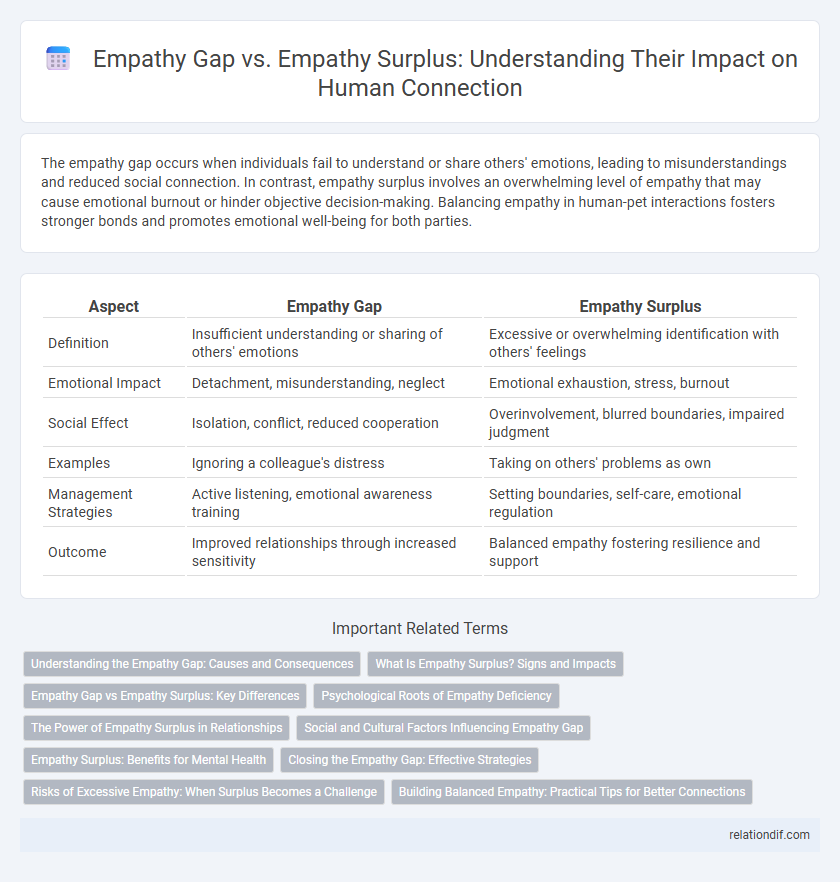The empathy gap occurs when individuals fail to understand or share others' emotions, leading to misunderstandings and reduced social connection. In contrast, empathy surplus involves an overwhelming level of empathy that may cause emotional burnout or hinder objective decision-making. Balancing empathy in human-pet interactions fosters stronger bonds and promotes emotional well-being for both parties.
Table of Comparison
| Aspect | Empathy Gap | Empathy Surplus |
|---|---|---|
| Definition | Insufficient understanding or sharing of others' emotions | Excessive or overwhelming identification with others' feelings |
| Emotional Impact | Detachment, misunderstanding, neglect | Emotional exhaustion, stress, burnout |
| Social Effect | Isolation, conflict, reduced cooperation | Overinvolvement, blurred boundaries, impaired judgment |
| Examples | Ignoring a colleague's distress | Taking on others' problems as own |
| Management Strategies | Active listening, emotional awareness training | Setting boundaries, self-care, emotional regulation |
| Outcome | Improved relationships through increased sensitivity | Balanced empathy fostering resilience and support |
Understanding the Empathy Gap: Causes and Consequences
The empathy gap refers to the cognitive bias where individuals underestimate the intensity or duration of others' emotional states, often leading to misjudgments in social interactions and decision-making. Causes of this gap include psychological distance, differing experiences, and emotional self-regulation challenges, which impair accurate perspective-taking and emotional resonance. Consequences of the empathy gap manifest in weakened interpersonal relationships, reduced prosocial behavior, and impaired conflict resolution, highlighting the importance of targeted empathy training and awareness.
What Is Empathy Surplus? Signs and Impacts
Empathy surplus occurs when individuals excessively absorb others' emotions, leading to emotional overwhelm and difficulty setting healthy boundaries. Signs include chronic fatigue, emotional exhaustion, and persistent anxiety due to constant emotional engagement. This surplus can impair decision-making, reduce personal well-being, and increase susceptibility to stress-related disorders.
Empathy Gap vs Empathy Surplus: Key Differences
Empathy gap refers to the inability or failure to accurately perceive and understand others' emotions, often leading to misunderstandings and social disconnect. Empathy surplus occurs when one over-identifies with others' feelings, potentially causing emotional burnout or blurred boundaries. Key differences lie in the balance of emotional engagement: empathy gap results in emotional detachment, while empathy surplus leads to excessive emotional involvement.
Psychological Roots of Empathy Deficiency
The empathy gap stems from psychological barriers such as cognitive biases, emotional disconnection, and in-group favoritism, which limit an individual's ability to accurately perceive and share others' feelings. Conversely, empathy surplus may result from excessive emotional attunement or over-identification, leading to emotional exhaustion or blurred boundaries. Understanding these psychological roots reveals how empathy deficiencies fluctuate between under- and over-empathizing, impacting social interactions and emotional regulation.
The Power of Empathy Surplus in Relationships
Empathy surplus enhances emotional connection by fostering deeper understanding and trust between individuals, strengthening relationship bonds. This overflow of empathy allows partners to anticipate emotions and respond supportively, reducing conflicts and increasing intimacy. Cultivating empathy surplus creates a resilient foundation for long-term relational satisfaction and mutual growth.
Social and Cultural Factors Influencing Empathy Gap
Social and cultural factors such as group identity, social norms, and cultural values significantly contribute to the empathy gap by limiting individuals' ability to understand experiences outside their own social group. Empathy surplus can emerge in diverse and inclusive environments where exposure to different cultures and perspectives fosters emotional resonance and reduces bias. Media representation, education, and intergroup contact are critical in shaping these social influences and determining whether empathy gaps or surpluses prevail in a community.
Empathy Surplus: Benefits for Mental Health
Empathy surplus, characterized by heightened emotional sensitivity and deep understanding of others' feelings, can enhance mental health by fostering stronger social connections and reducing feelings of isolation. This amplified empathetic capacity promotes emotional resilience and supports the development of healthier coping mechanisms in stressful situations. Increased empathy also encourages prosocial behavior and improved communication, which contribute to overall psychological well-being.
Closing the Empathy Gap: Effective Strategies
Closing the empathy gap requires targeted strategies such as active listening, perspective-taking, and emotional validation that foster deeper understanding and connection. Empathy surplus, characterized by excessive emotional involvement, can be mitigated through setting healthy boundaries and cultivating emotional resilience. Organizations and individuals who implement these approaches effectively enhance communication, reduce conflicts, and promote inclusive environments.
Risks of Excessive Empathy: When Surplus Becomes a Challenge
Excessive empathy, or empathy surplus, can lead to emotional exhaustion, blurred boundaries, and impaired decision-making, increasing the risk of burnout especially in caregiving professions. The empathy gap occurs when individuals fail to fully understand or share others' feelings, but an empathy surplus may overwhelm personal resilience and reduce objective judgment. Balancing empathy is crucial to maintaining mental health and effective interpersonal relationships without sacrificing one's own well-being.
Building Balanced Empathy: Practical Tips for Better Connections
Building balanced empathy requires recognizing the pitfalls of the empathy gap, where understanding others' feelings is limited, and the empathy surplus, which can lead to emotional exhaustion. Practicing active listening, setting healthy emotional boundaries, and cultivating self-awareness promote sustainable empathy. These strategies enhance meaningful connections while preserving personal well-being and emotional resilience.
Empathy gap vs empathy surplus Infographic

 relationdif.com
relationdif.com